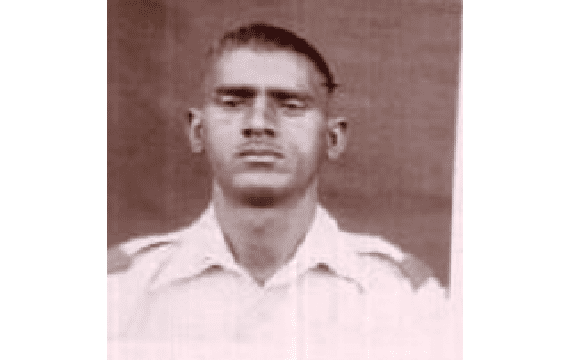
Service No : 4142021
Place of birth : Mahendragarh, (Har)
Service : Army
Last Rank : Sepoy
Unit : 13 Kumaon
Arm/Regt : The Kumaon Regiment
Operation : Indo-China War 1962
Martyrdom : November 18, 1962
Sepoy Shri Chand
Sepoy Shri Chand hailed from Rampuri village in Mahendragarh district, Haryana—a region renowned for its rich martial heritage and unwavering commitment to national service. Inspired by a deep sense of patriotism, he enlisted in the 13 Kumaon Battalion of the esteemed Kumaon Regiment, one of the Indian Army’s oldest and most decorated infantry regiments. With roots tracing back to the 18th century, the Kumaon Regiment has earned a stellar reputation for its courage, professionalism, and gallantry in numerous military engagements.
As a soldier, Sepoy Shri Chand exemplified unwavering dedication, discipline, and loyalty to duty. He wore the Kumaoni uniform with great pride and upheld the regiment’s traditions with integrity and honour. By 1962, his battalion was stationed in Ambala and was subsequently deployed to Jammu & Kashmir, a testament to the trust reposed in their combat readiness and strategic importance.
Battle of Rezang La (Indo-China War): 18 Nov 1962
In June 1962, Sepoy Shri Chand’s unit, the 13 Kumaon Battalion, under the command of Lt Col H.S. Dhingra, was relocated from Ambala to Baramulla in Jammu & Kashmir. As tensions with China escalated later that year, the battalion received orders in September 1962 to move to Leh at short notice. It was placed under the operational command of the 114th Infantry Brigade, led by Brigadier T.N. Raina (who later rose to become the Chief of Army Staff). The brigade was tasked with defending a vast 400 km stretch of the Indo-China border, including the strategically vital Chushul sector. Alongside 13 Kumaon, the brigade also comprised the 14 J&K Militia, 7 J&K Militia, 5 Jat, and 1/8 Gorkha Rifles. Sepoy Shri Chand served in ‘C’ Company, commanded by Major Shaitan Singh, and was deployed at Rezang La as part of the brigade’s operational strategy. ‘A’ Company, under Maj G.N. Sinha, was held in reserve at battalion headquarters near Chushul, while ‘B’ and ‘D’ Companies were positioned on Maggar Hill, under the leadership of Capt R.V. Jatar. By 26 October 1962, Sep Shri Chand and his fellow soldiers had fortified their positions at Rezang La in preparation for combat.
‘C’ Company was tactically deployed across the forward slopes of Rezang La to maximize the defense advantage. 7 Platoon, under Jemadar Surja Ram, secured the northern flank; 8 Platoon, led by Jemadar Hari Ram, held the pass; and 9 Platoon, commanded by Jemadar Ram Chander, manned the central post, supported by Company HQ. A mortar section, under Naik Ram Kumar Yadav, was placed on the reverse slope. The Chinese assault began on 18 November 1962, coinciding with a larger offensive at Sela in NEFA. A two-pronged attack was launched—one toward Gurung Hill, and the other directly targeting ‘C’ Company at Rezang La, which overlooked the vital road connecting Leh via Dungti, making it a strategic stronghold for defending Chushul airfield.
The first wave of attack came at 2:00 AM, directed at Platoon 8. Enemy movement was detected by the Listening Post, and Naik Hukam Chand swiftly alerted Jemadar Hari Ram, who coordinated with Capt Shaitan Singh and ordered a counteroffensive with an LMG section. When the enemy approached within 50 yards, the Indian soldiers opened fire, successfully repelling the first wave. The second wave followed at 4:00 AM, attacking from the direction of Platoon 7. Jemadar Surja Ram, along with Naik Sahi Ram, launched a fierce counterattack using rifles, grenades, and light machine guns. Their quick action halted the second assault. The Chinese pressed on, launching additional waves at 4:55 AM, 6:00 AM, and 6:30 AM. Sep Shri Chand and his fellow soldiers fought with extraordinary grit, holding their ground against overwhelming odds. By the sixth wave at 7:40 AM, the defenders were heavily outnumbered and depleted. At 8:40 AM, the Chinese introduced a 57 mm recoilless rifle, openly positioned on the ridge. The seventh and final assault began at 9:00 AM.
Despite freezing temperatures, rugged terrain, and heavy bombardment, Sepoy Shri Chand and his comrades of ‘C’ Company stood their ground with unwavering resolve. Sep Shri Chand sustained serious injuries during the intense combat and made the supreme sacrifice. Their valiant stand at Rezang La not only stalled the Chinese advance but also ensured the defense of Chushul airfield. After the ceasefire, Rezang La became a no-man’s land, claimed by both sides. The bodies of Sep Shri Chand and his fallen brothers-in-arms remained buried under snow until a local shepherd discovered them nearly three months later.
Sepoy Shri Chand is survived by his wife, Smt Gindori Devi.

No Comments